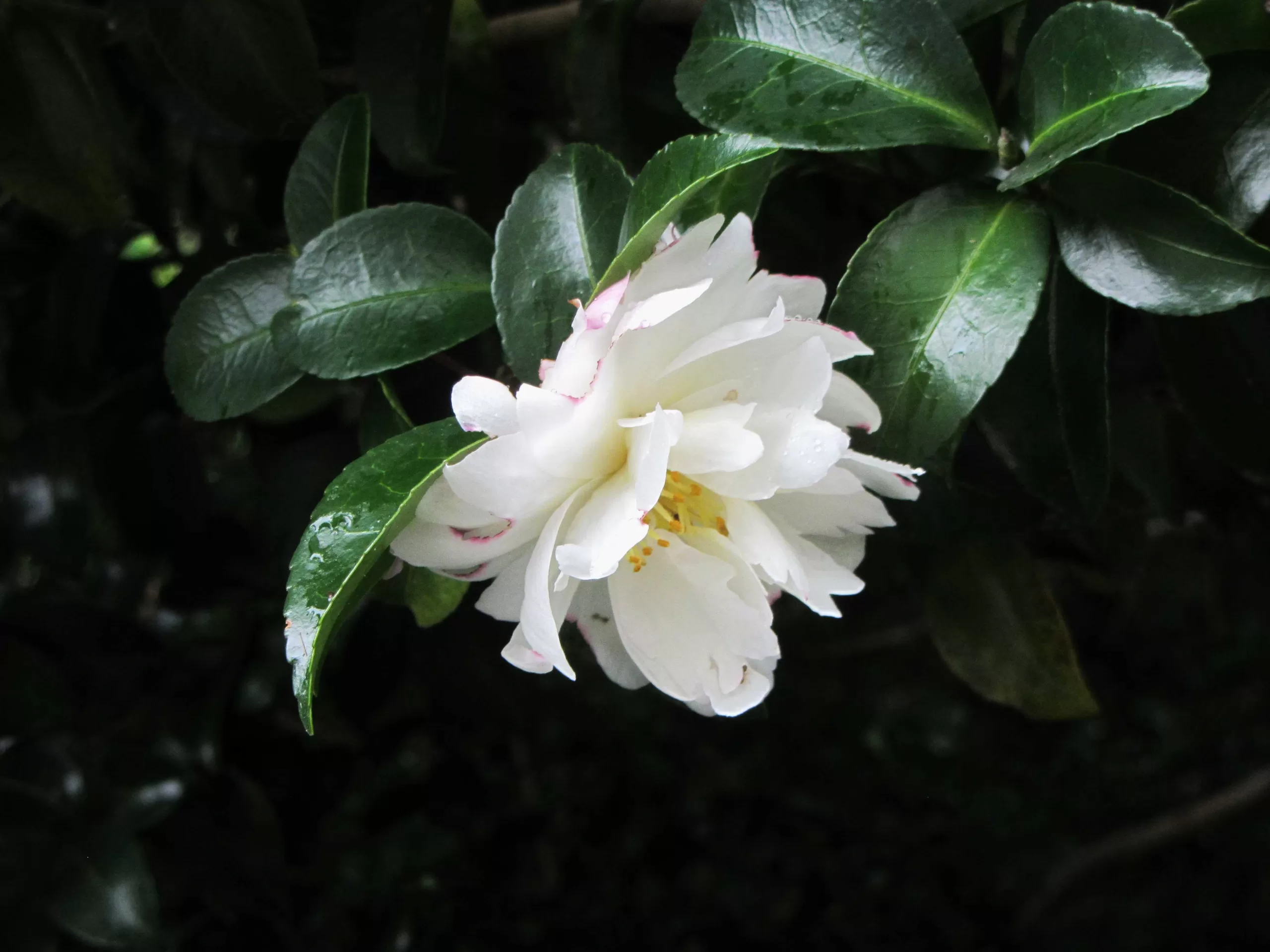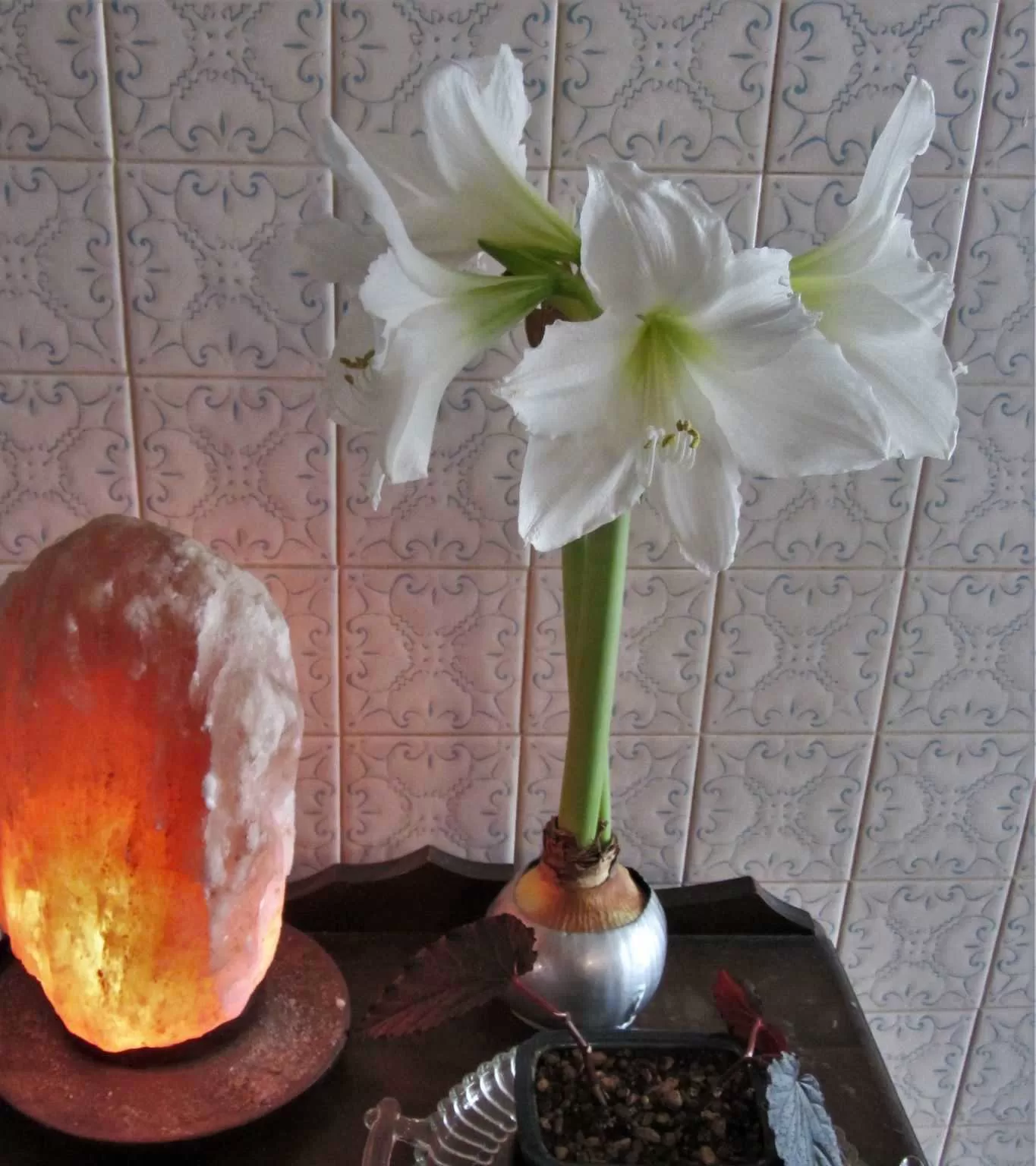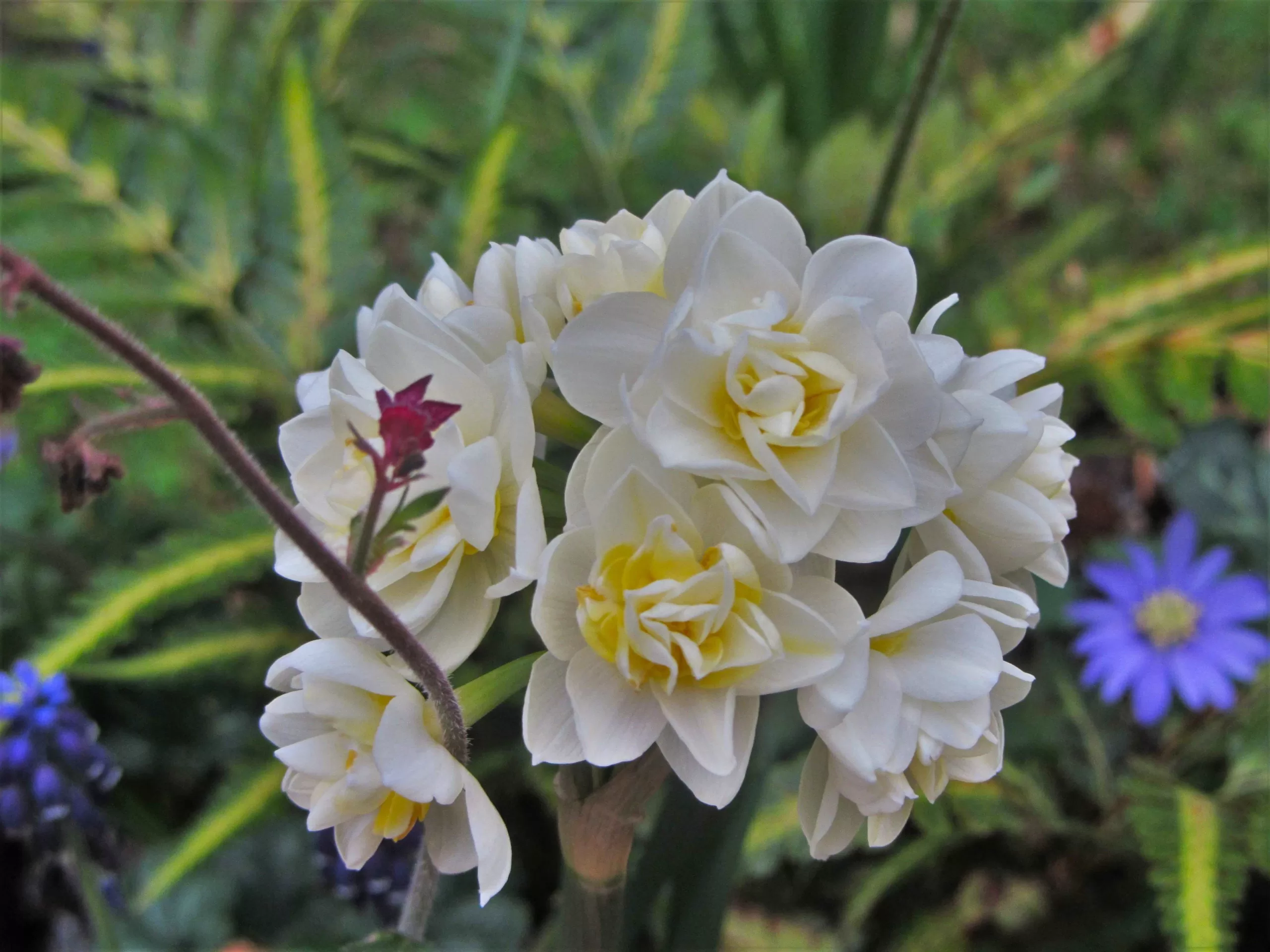Winter in the Garden: To Do, To Do Less, and What to Avoid
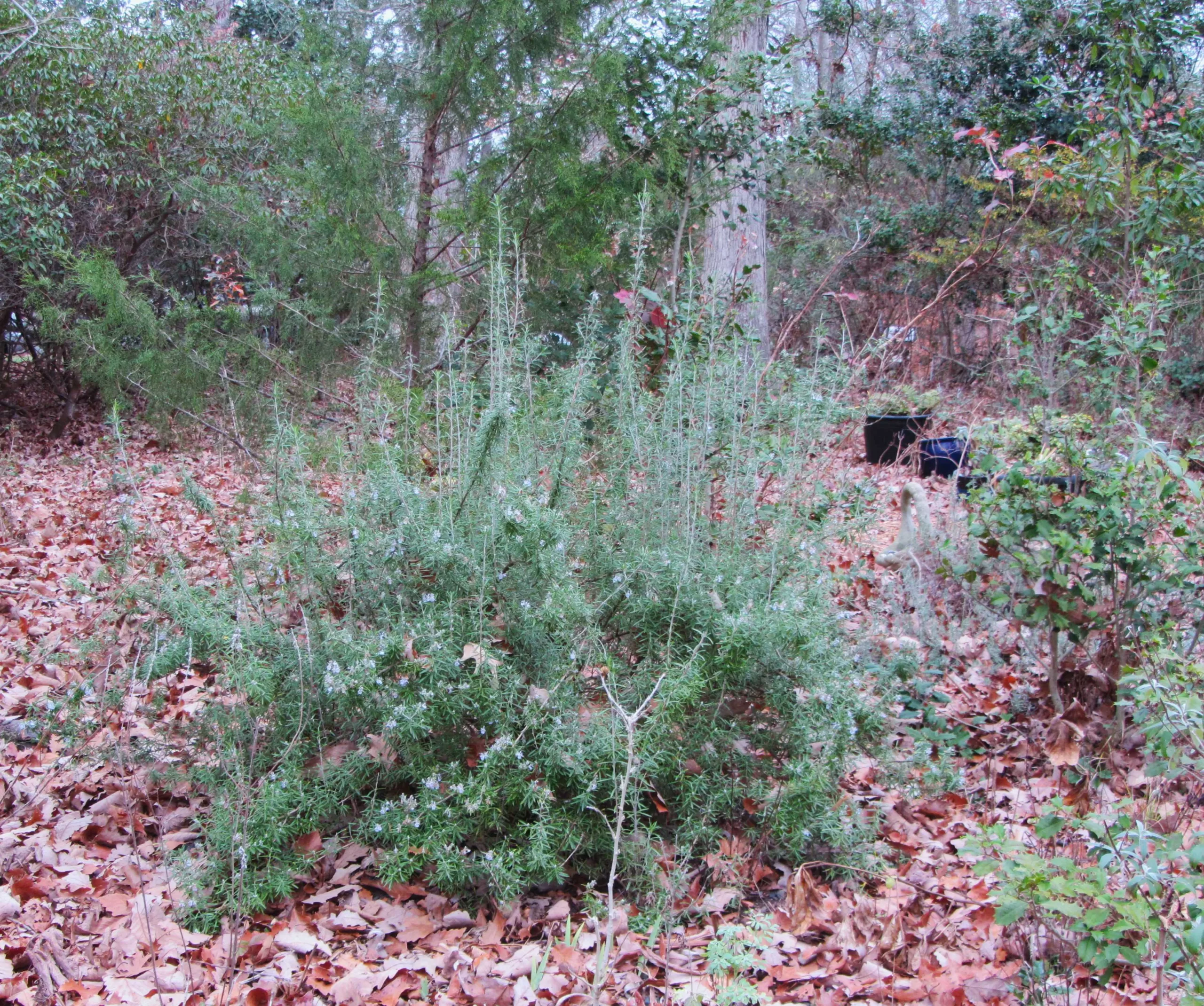
Evergreen plants support the ecosystem in your yard throughout the winter. Rosemary blooms in the winter, offering food to hungry insects on warm days.
We can consider winter as the ‘weekend’ of the gardening year, both the last month and the first months of the year when we can enjoy a much-needed rest from the regular routine. A period of rest and renewal restores energy to both the garden and the gardener. It allows us time for reflection on the successes and challenges of seasons past and an opportunity to plan and prepare for the seasons to come.
If winter is the weekend, then evergreen plants are like those stalwart workers who keep the restaurants, gas stations and grocery stores open for us on Sundays and holidays. Evergreens continue their work while the rest of the plant world slumbers in dormancy. Every garden needs a few evergreen plants to shine as the structure and star players of the winter landscape. More importantly, they remain functional through the winter months, filtering the air, sequestering carbon and some pollutants, releasing oxygen, enlarging their root systems, and processing water from the ground back into the atmosphere.
Evergreens that flower in winter, like Camellia sasanqua and C. japonica, Helleborus spp. and hybrids, and Berberis bealei, feed bees and other pollinators who awaken on warm winter days. Other evergreens like pine, juniper, holly, and firethorn provide seeds and drupes for birds and other small animals to eat through the winter. They may attract insects that birds can hunt. They keep energy circulating through the ecosystem all winter. Many of these evergreen plants come on the market at local nurseries in late fall and are easiest to find during winter, so add a few of these to your planting plans.
Frost dates and USDA hardiness zones are changing in many areas of our country, as they are also changing around the planet in response to climate change. That means that as our growing season lengthens, our winters grow shorter. This change has many implications for us all, and particularly for gardeners. Our hardiness zone shifted from 7b to 8a in November, after 30 years of USDA climate data indicated that our lowest winter temperatures have shifted upwards.
Some cherished plants may no longer thrive in our area because they no longer get the ‘chilling hours’ they need in sub-freezing temperatures. Insect species that once died out each winter may now survive in greater numbers to spread diseases to plants, pets, and people. Insects that once couldn’t survive in our climate may now migrate to our area and naturalize, causing lethal damage to some plants.
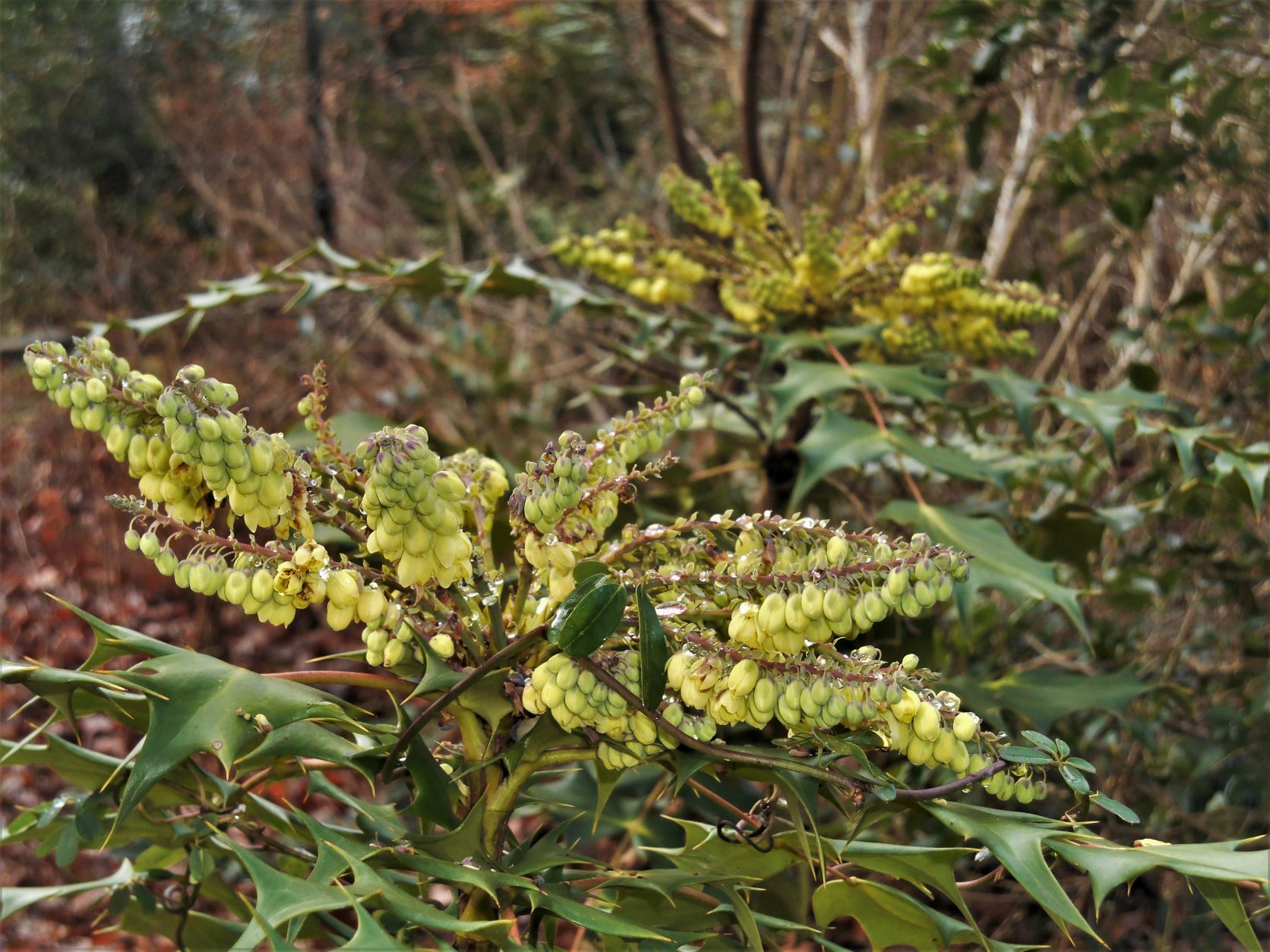
Oregon grape holly is native to Asia and has naturalized in our region. It blooms from December through March and supports both pollinating insects and birds.
Native insects remain active for more days each year, responding to warm spells even during the periods when they normally hibernate. Cold-sensitive reptiles and amphibians may also remain active later into the fall and awaken earlier in the spring than ever before. These small animals and insects need food sources during the winter. Food that may not be provided by native plants, which are still dormant or in early stages of growth. When the timing of nature is shifting, ‘species shift’ is inevitable to meet the need. We can help animals adapt in the short term by providing a wide diversity of plants in our home landscape, including those that bloom through the winter.
But later fall frost dates and earlier dates for the last frost in spring also open up possibilities for a longer growing season for both ornamental and food producing plants. Our gardens can become more productive as we sow and harvest both early and late veggie crops. More tender fruiting trees like pomegranates, figs and bananas may now produce in sheltered areas of our yard.
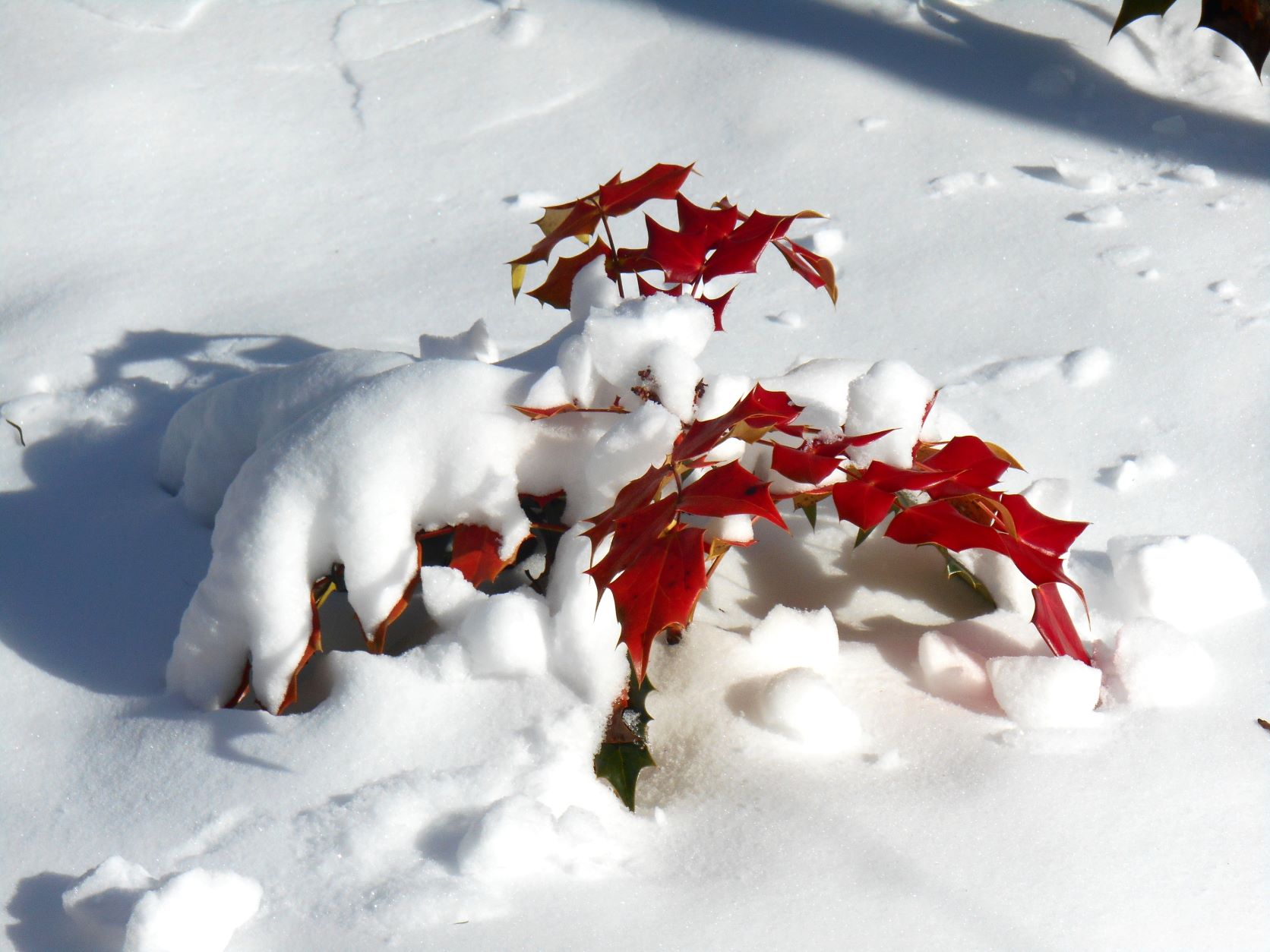
Some evergreen plants, like Oregon grape holly, turn red to help withstand the cold. Snow insulates plants from the cold, and melts slowly, allowing water to replenish the soil instead of running off.
While we may welcome less snow to shovel, snowfall is important for replenishing groundwater. When it lingers and melts slowly, it can soak in deeply. Heavy rains may run-off before soaking into the soil. Snow piled onto planting beds insulates and protects perennial crowns while giving the beds extra water. Years with little or no snowfall can make droughts the following summer that much harder on trees and other deeply rooted plants. Be careful to keep ice melt products away from ornamental plantings as too much salt lingers in the soil, and some chemicals in these products may hurt permanent plantings.
While winter is a great time to dig into gardening books, plant catalogs, and horticultural websites from the comfort of our favorite armchair, there are still a few tasks to attend to, as weather permits.
Protect and Preserve:
To Do:
Gather, clean, and store garden ornaments, hummingbird feeders, and furniture that won’t be in use during the winter and that may be damaged by freezing weather and winter storms. Anything that can hold water can get damaged when that water freezes and expands. This includes ceramic pots and glassware, wooden furniture and ornaments, and some decorative lighting. Some glazed pots are ‘frost proof’ and may be fine to plant with winter arrangements over the winter. Unglazed pottery is most vulnerable to cracking if left filled with potting mix.
Cover outside spigots with insulated covers and disconnect and drain hoses. Turn water off to in-ground sprinkler systems.
Pull mulch away from woody stems of shrubs and trees to protect from voles.
Consider wrapping trunks of young trees or installing ‘cages’ around them to protect from voles and male deer who may use trunks to ‘scratch’ their heads, thus damaging the bark.
Use animal repellent products to protect trees and shrubs from grazing deer, who remain hungry and active all winter. Spray new bulbs with liquid repellent before planting them because squirrels may try to dig up newly planted bulbs and voles or squirrels may eat them.
Clean and Organize
To Do:
Wash empty ceramic pots so they are ready for spring planting. Organize your collection of plastic nursery pots by size and recycle any pots or trays you won’t need. At the same time, inventory other supplies such as gloves, tools, soil amendments, and potting soil. Some garden centers offer tools and supplies at a discount in December and January. Tools should be cleaned and lubricated, blades sharpened, screws tightened and prepared for spring. 3M oil is good for cleaning and lubricating tools. Disinfect pruning tools with a spray disinfectant between uses.
Pick-up any fallen sticks or branches and use them to create a brush pile somewhere out of sight and out of the way. Birds will hunt there for over-wintering insects and larvae. Eventually, the wood will break down and return to the soil. You can speed the process along by cutting up or chipping up the sticks in the spring, after larvae have had a chance to emerge.
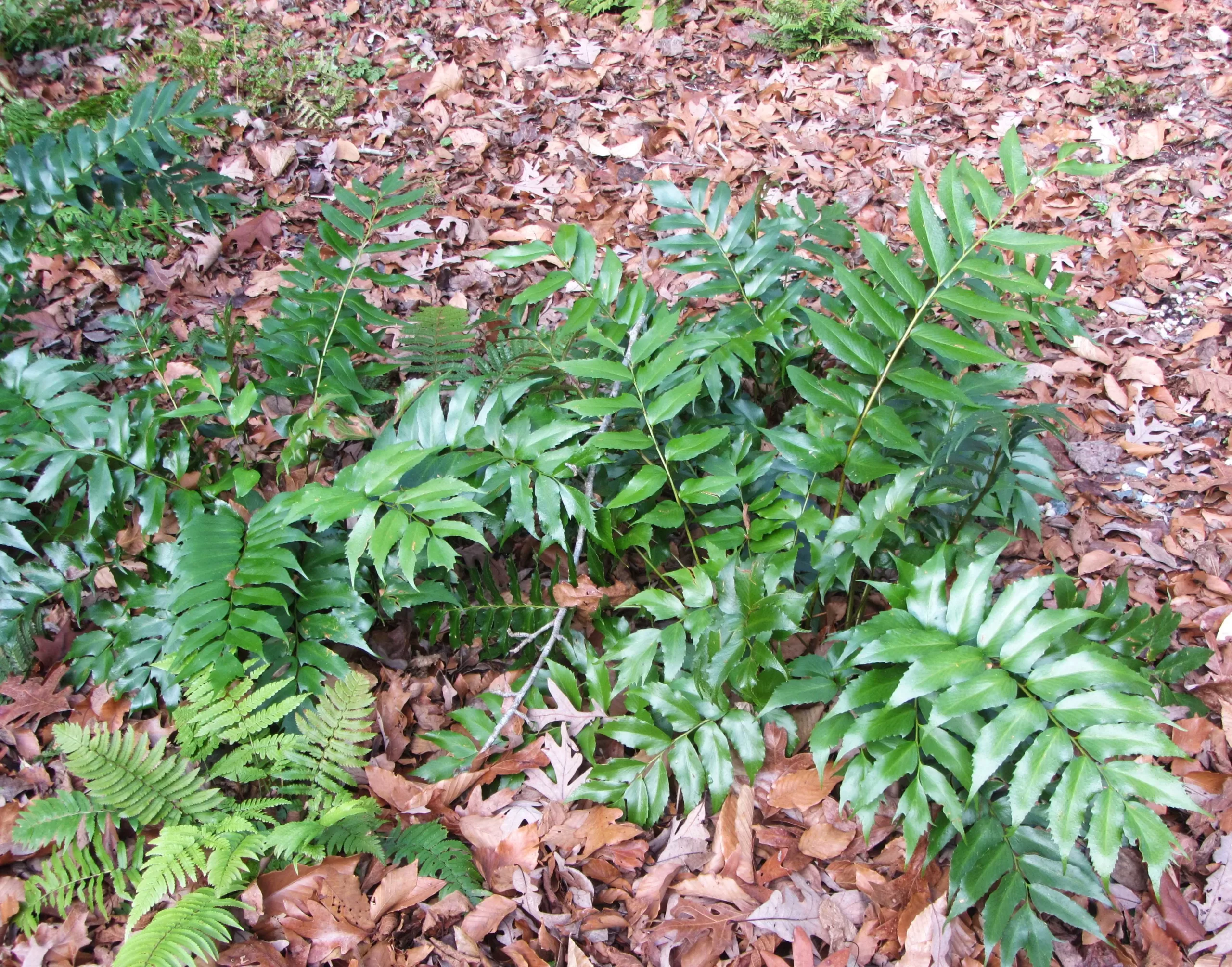
Evergreen ferns and other perennials give structure to the garden and continue to function through the winter. Pick up sticks and branches as they fall to prevent damage to perennials.
Plan Ahead:
To Do:
Walk around and look closely at what is currently happening in your yard. What pleases you? What is working out well? What annoys you? What could be better?
Dream a little about what could make your yard more functional and more attractive. How can you address any problem areas where erosion, poor traffic patterns, poorly performing plants, or lack of privacy present challenges? How can your yard support more wildlife? Can you make your yard more environmentally friendly? Notice what needs to be done before spring, including any pruning of trees or shrubs you need to tackle while they are dormant. Consider where you might want to enlarge or create new planting beds, sitting areas, or raised beds.
Plan what to grow in the coming year and order seed packets and perennial crowns when they come on the market. But wait for the first flush of enthusiasm to pass before turning your ‘wish list’ into an order. Let a realistic assessment of available space to plant and available time to end the plantings guide your actual purchases. Keep records of each type of plant ordered and exactly where you expect to plant it. It is easy to forget over time exactly where you intended to plant some new perennial or shrub delivered in March or April, months after you placed the order.
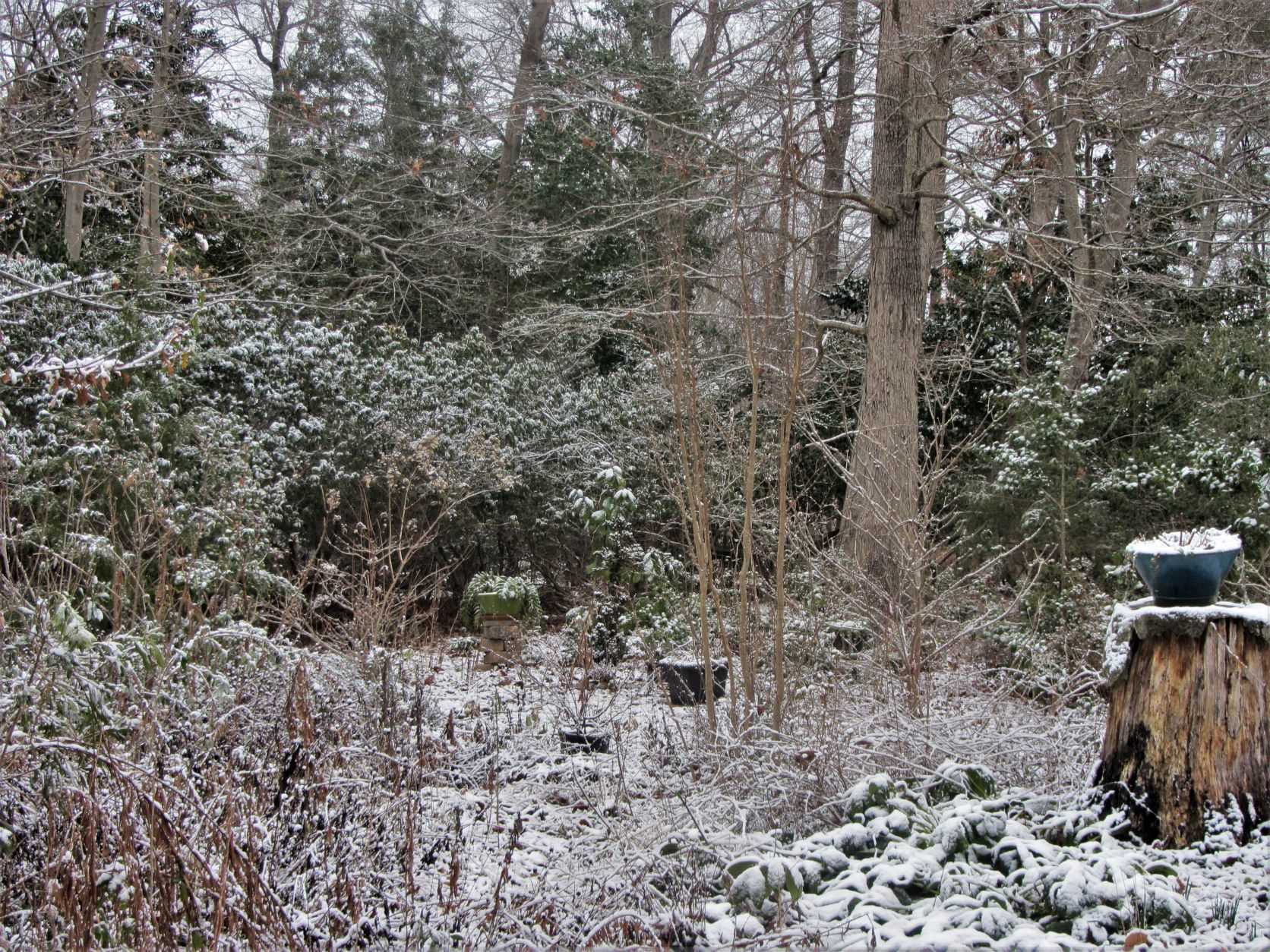
Consider what new plants you have room for, and where you can realistically plant them, before ordering new plants during the winter. Make note of where each purchase is intended to grow.
Quite often, the same or a similar plant will be available, already leafed out and growing, at a local nursery in the spring. For a fraction of the mail-order price, you can choose your own healthy plant. Mail ordered plants sometimes arrive rather late in the season to start bare-root plants successfully. Local retailers usually carry a good selection of common bare-root plants like Hostas, lilies, berry bushes, and ferns, beginning in February.
Review any garden notes you made during past seasons and plan ahead for what you want to accomplish during the coming year. You may want to tweak the timing to plant earlier or later, to postpone some tasks, or accomplish others you ran out of time to do last year. Get the year off to a fresh start with a new garden calendar or journal and a realistic plan.
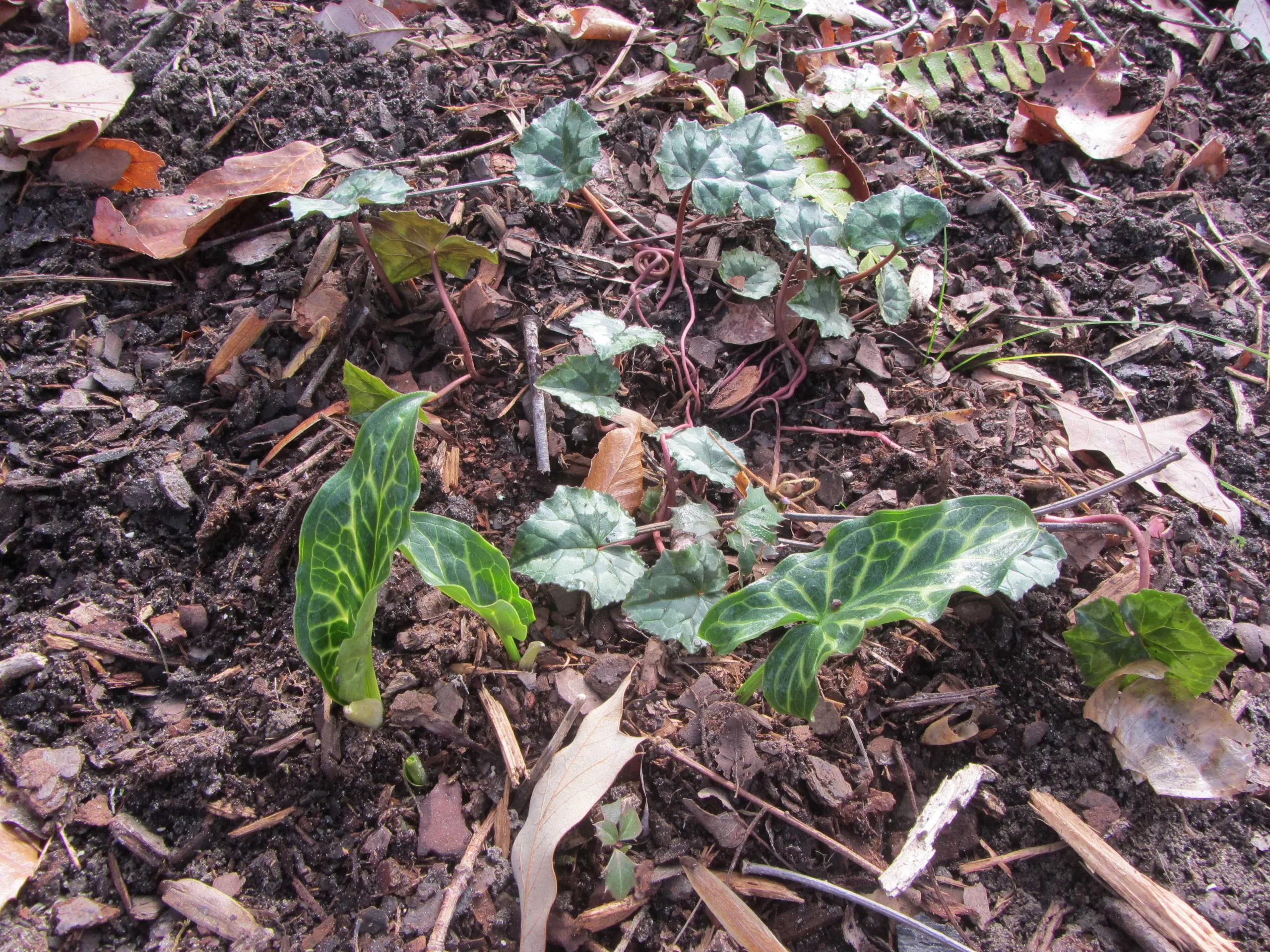
Spray new bulbs, rhizomes and tubers with animal repellent spray at planting time to discourage squirrels from digging up your new plantings. Here newly planted Arum italicum and fall blooming Cyclamen have just begun to grow in the midst of much interest from the squirrels.
Improve the Soil
To Do:
Cover the soil with bark mulch, pine tags, straw, gravel mulch, chipped wood mulch or chopped leaves during the winter. Organic mulches will decompose, protecting organisms living in the soil and replacing humus content. They will also keep sequestered carbon in the soil. Exposed soil can allow carbon, stored in the rich, dark organic matter known as humus, to return to gaseous form.
Powdered or pelletized lime is used to change the pH of the soil from acidic (pH of 6.5 and below) to more neutral, or even sweet (alkaline). Perform a soil test to check the pH of the soil before adding lime. If you send the soil test off to an Extension office lab for evaluation, they will prescribe how many pounds of lime to spread in a given area to change the soil’s pH for what you intend to plant. Lime is most often used on lawns, but is also used for roses, lilacs, and some perennials.
Other soil amendments, like greensand, rock phosphate, and Epsom salts (magnesium sulphate) can improve fertility and plant growth by correcting mineral deficiencies in the soil. There are also products and special fertilizer blends that make soil more acidic to support ericaceous, or acid loving plants. But these products only help when there is a deficiency to begin with.
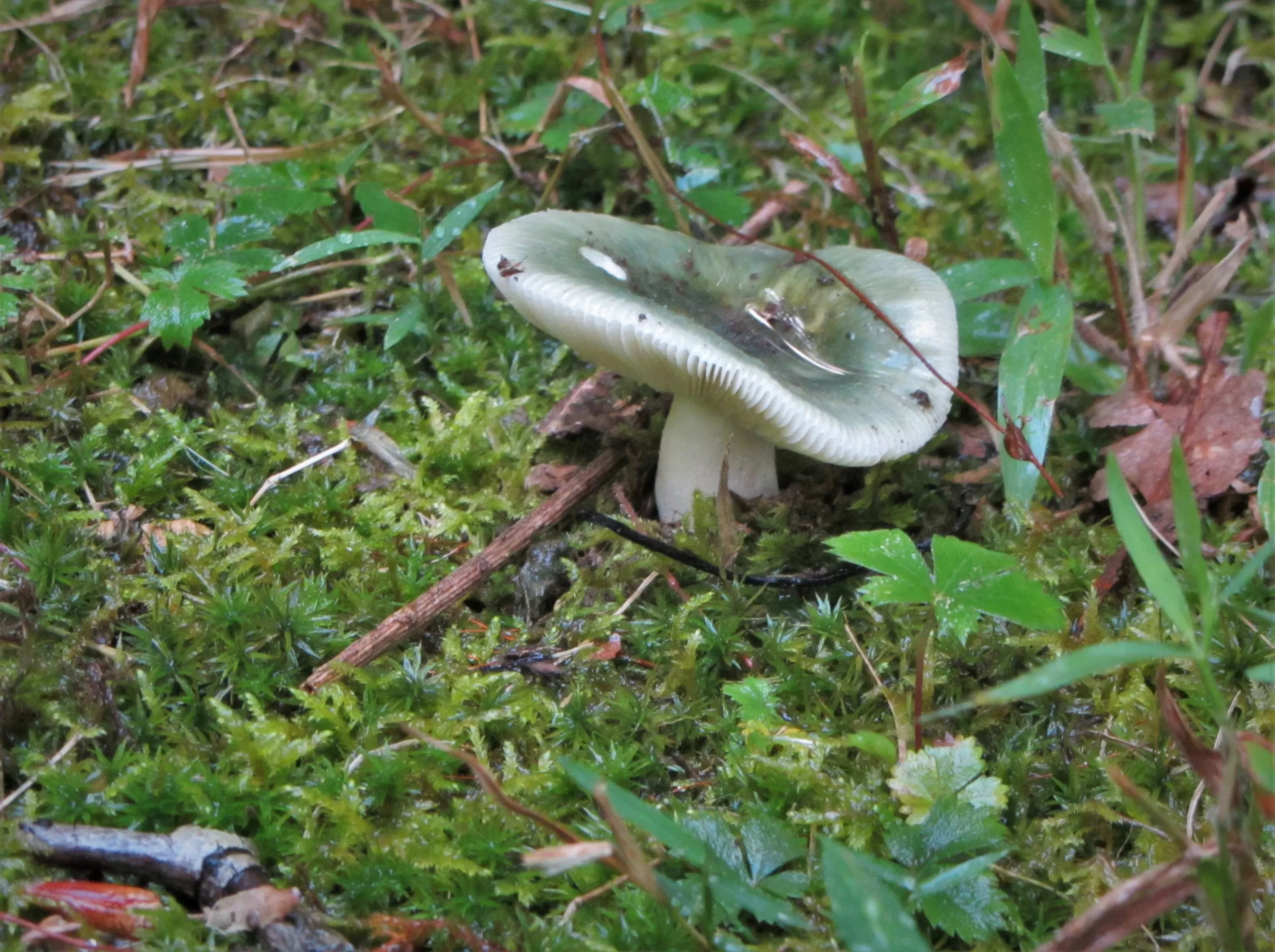
Moss is a living mulch that remains green in winter. Mushrooms indicate that your soil is alive with mycelium, healthy and taking care of nearby plants. Digging and tilling the soil disrupt the important mycelium networks which help transport food and chemical signals between plants and help trees to grow.
It is always smart to test the soil before adding soil amendments and fertilizers. Too much nitrogen and phosphate will simply run off into nearby waterways, polluting those waterways. Just routinely fertilizing each winter or spring can cause more harm than good to the soil, to plants, to organisms living in the soil, and to nearby waterways.
Watch for any perennials that may ‘heave’ out of the ground during the freeze/thaw cycle, gently push them back into the ground and add additional mulch to protect them. Notice areas around shrubs or in perennial beds where the mulch has grown thin, or washed away, and add as needed to protect the roots from winter cold.
Add compostable materials like coffee grounds, tea leaves, rinsed eggshells, and non-citrus fruit and vegetable peels to your compost pile or an area where you are sheet composting to prepare a new area for spring planting. Shredded paper and non-treated cardboard may also be composted. Beware of colored inks on cardboard or paper that may add unwanted chemicals to your soil, however.
Even raised beds and vegetable gardens should have a cover crop or mulch covering and protecting the soil over winter.
To Do Less:
While conventional garden wisdom recommends chopping up fallen leaves for use as mulch, particularly around trees and shrubs, some butterfly, moth, and other insect larvae may be overwintering, curled up in a fallen leaf or attached to a perennial stem. Plan to leave some areas of fallen leaves and standing perennials until spring before chopping and clearing them.
To Avoid:
Keep mulch an inch or so away from the trunks of trees and shrubs so that voles can’t use the cover of mulch to attack their bark. Mulch can also keep the bark too wet, allowing insects to attack and disease to develop in the bark and infect the wood. This type of damage to the bark, near ground level, can eventually kill a tree or shrub. Even though some landscapers pile mulch around the base of trees in ‘mulch volcanoes,’ this practice is harmful to a tree.
Avoid digging your garden soil in winter. Not only does digging and tilling release stored carbon back into the atmosphere, but tilling wet soil can destroy its texture, and tilling will disrupt and kill many of the organisms in the soil that make it rich and productive. Mycelium (fungal) networks link plants and carry food and chemical ‘messages’ between the roots of various plants in a given area. Some bees nest underground in winter, and invertebrates and their larvae help process organic materials into rich humus.
Prepare new garden areas by mowing any grass as low as possible before covering the area with several thicknesses of brown grocery bags or newsprint, which will smother whatever is currently growing. Avoid spraying herbicides which will remain in the soil and get into the groundwater. Cover this paper barrier with organic materials. Consider using bagged topsoil or compost to build up the new bed, in addition to shredded leaves, wood chips, straw, manure, and other available compostable materials. This pile should be decomposed and ready to plant by mid-spring.
Avoid walking on lawns and garden beds when the soil is saturated because walking and driving on soil can cause soil compaction. This is especially important where clay content is high.
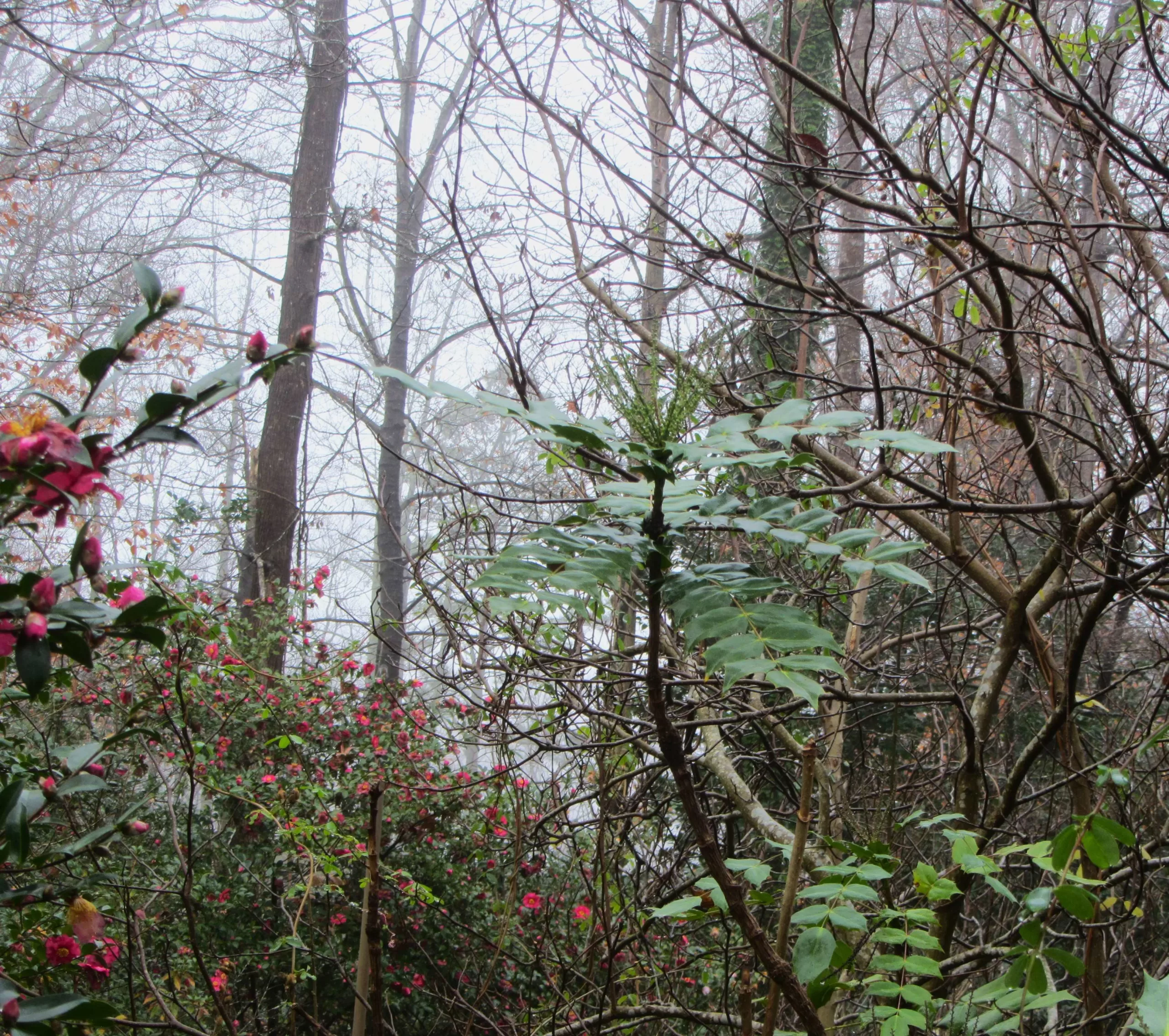
Regular, strategic pruning keeps woody plants healthy. Evaluate each shrub for broken, dead, or diseased branches and to see where branches may be rubbing against one another. Wait to prune spring blooming shrubs and trees until they have finished blooming. Prune out vines trying to grow up through the shrubs in winter while you can see and reach the vines.
Prune
To Do:
Evaluate each shrub and tree in your yard to look for dead or diseased wood, which should be removed. Crossed branches rubbing against one another should be corrected by removing one of them. Any branch growing back into the center of a shrub should be removed. Large trees may need a professional to removed dead or diseased branches, but homeowners should be able to manage smaller trees and shrubs with both feet on the ground.
Remove dead or diseased branches at any time of the year for the overall health of the shrub.
Remove any remaining flowering heads from summer flowering shrubs like Hydrangeas. Older Hydrangeas may be rejuvenated by cutting back a third of the oldest stems each winter. Cut the old stems as close to the ground as possible. Shape and thin the shrub to allow for air circulation. Do this on any shrub that blooms on newly grown wood each year.

Rose of Sharon seeds remain available for birds and squirrels all winter, even when the seed capsules are covered in snow and ice. Prune away the seed capsules and reduce the length of the stems before new growth appears in spring. Rose of Sharon grows very tall and lanky without annual pruning.
Remove old crape myrtle and rose of Sharon seed heads in late winter as the birds will continue to feed on them so long as seeds remain. Invest in good sharp loppers, hand pruners, and a small, folding hand saw for this annual work.
Also leave seed heads on herbaceous perennials as long as possible. Wait to clean up remaining stems just as daffodils and other spring flowering bulbs begin to emerge. Birds will eat these seeds during the winter, and some insects may be overwintering in their hollow stems.
Evergreen perennials like Hellebores, Epimediums and certain ferns may have older, ratty looking leaves by late December. Cutting these older leaves away allows new leaves and flower stems to emerge more visibly and the plant will look better, overall.
Remove spent flowers from holiday plants like Amaryllis, Poinsettia, florists’ Cyclamen, and Christmas cactus as they fade. Keep these plants in bright light and water as needed.
Remove the wax coating from any waxed Amaryllis bulbs after they bloom. Set the bulb in a shallow bowl with about ½” of water to stimulate new roots to grow. Pot up the Amaryllis in good potting mix in a 6” pot when the roots grow to around an inch long, and keep it well-watered in good light as the bulb restores it energy to bloom again next winter.
You can move Poinsettias and Christmas cactus outside after danger of frost. Cut back Poinsettia stems by about half and fertilize the plants when you move them outside to grow in part sun through the summer. Also fertilize Christmas cactus plants during the summer to encourage new growth, but don’t cut them back. Cyclamen is an ephemeral tuber. Leaves will eventually die down so the plant can rest. If you keep the pot just slightly damp in an out of the way place indoors, new growth will begin again in late summer or early fall.
To Do Less:
When older fern fronds are lying flat on the ground already, they are protecting the soil and may be left indefinitely to mulch the soil and eventually decompose. Remove them only if they are blocking new growth on a nearby plant.
Avoid pruning tender or marginal shrubs and perennials until new growth begins. Keep in mind that some shrubs, like roses, will be stimulated to begin new growth soon after pruning. That tender new growth can be killed by late frosts and so roses are best left alone until late winter. Wait to prune roses until new growth is visible.
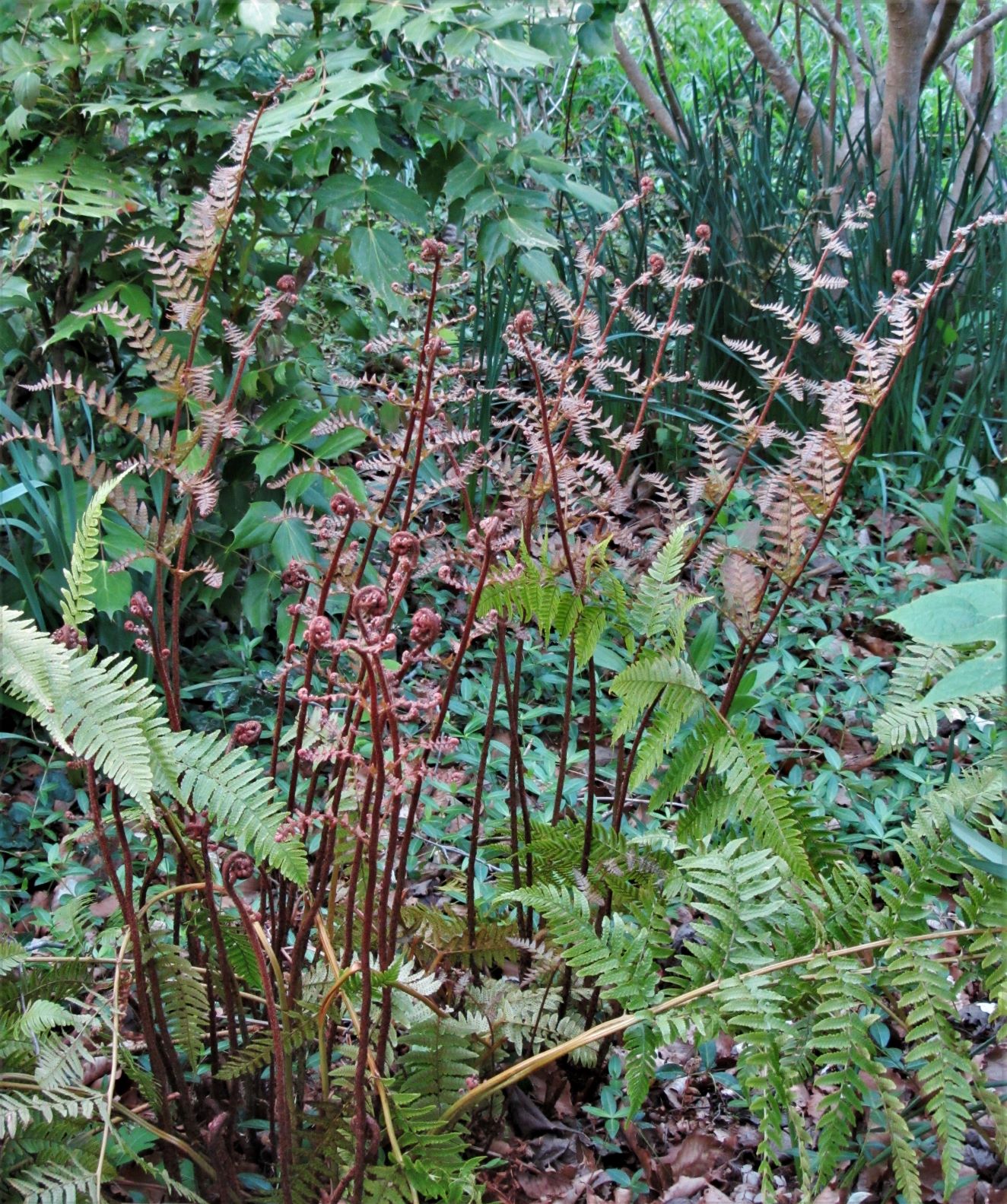
Dryopteris erythrosora ‘Brilliance’ holds up exceptionally well to winter weather. It is still wise to remove older, broken or discolored fronds as new fronds emerge. Imported ferns like this Asian cultivar may have similar needs and growth habits to native ferns of the same genus.
To Avoid:
Some flowering shrubs bloom on ‘old’ wood that grew during the previous season. All Rhododendrons, including azaleas, bloom on old wood. Pruning these shrubs before they bloom means pruning off the current year’s flowers. This is also true for other early spring blooming shrubs like Forsythia, flowering quince, Japanese Pieris, lilacs, Camellias and mountain laurel. Prune these shrubs, to control their size or to open them up, after they bloom but before the end of June. If you see broken, dead or diseased branches remove them immediately, as they are unlikely to bloom, anyway.
Watch Master Gardeners teach you how to prune
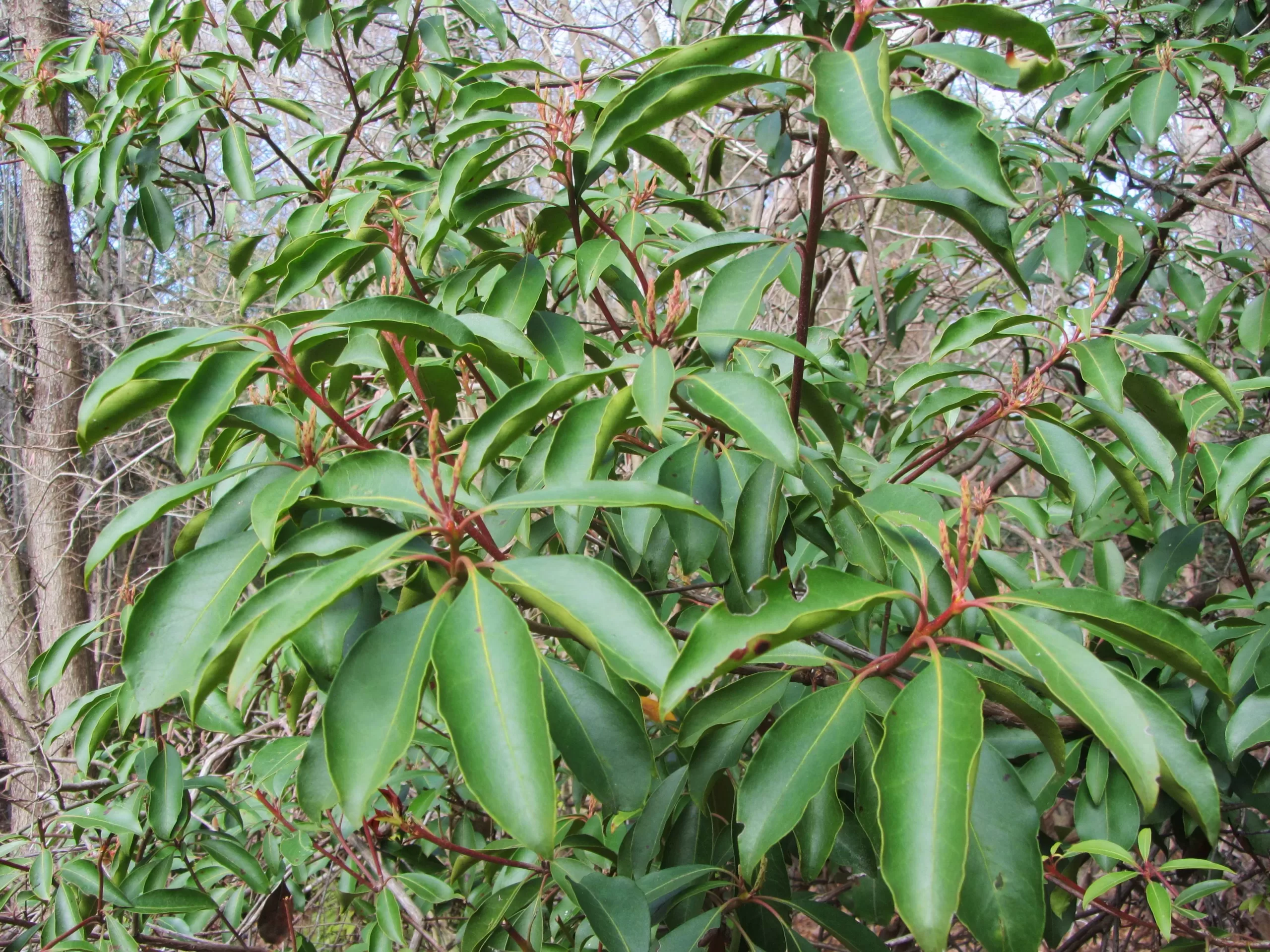
Mountain Laurel, and other spring blooming shrubs, are already covered with buds. Wait until after they bloom to perform routine pruning and thinning.
Plant
To Do:
While autumn is the best time to plant trees, shrubs, and perennials in our area, you can continue to plant through the winter whenever the ground isn’t frozen. Likewise with bulbs. Many people plant bulbs in the fall, but you can plant hardy spring flowering bulbs through at least mid-January.
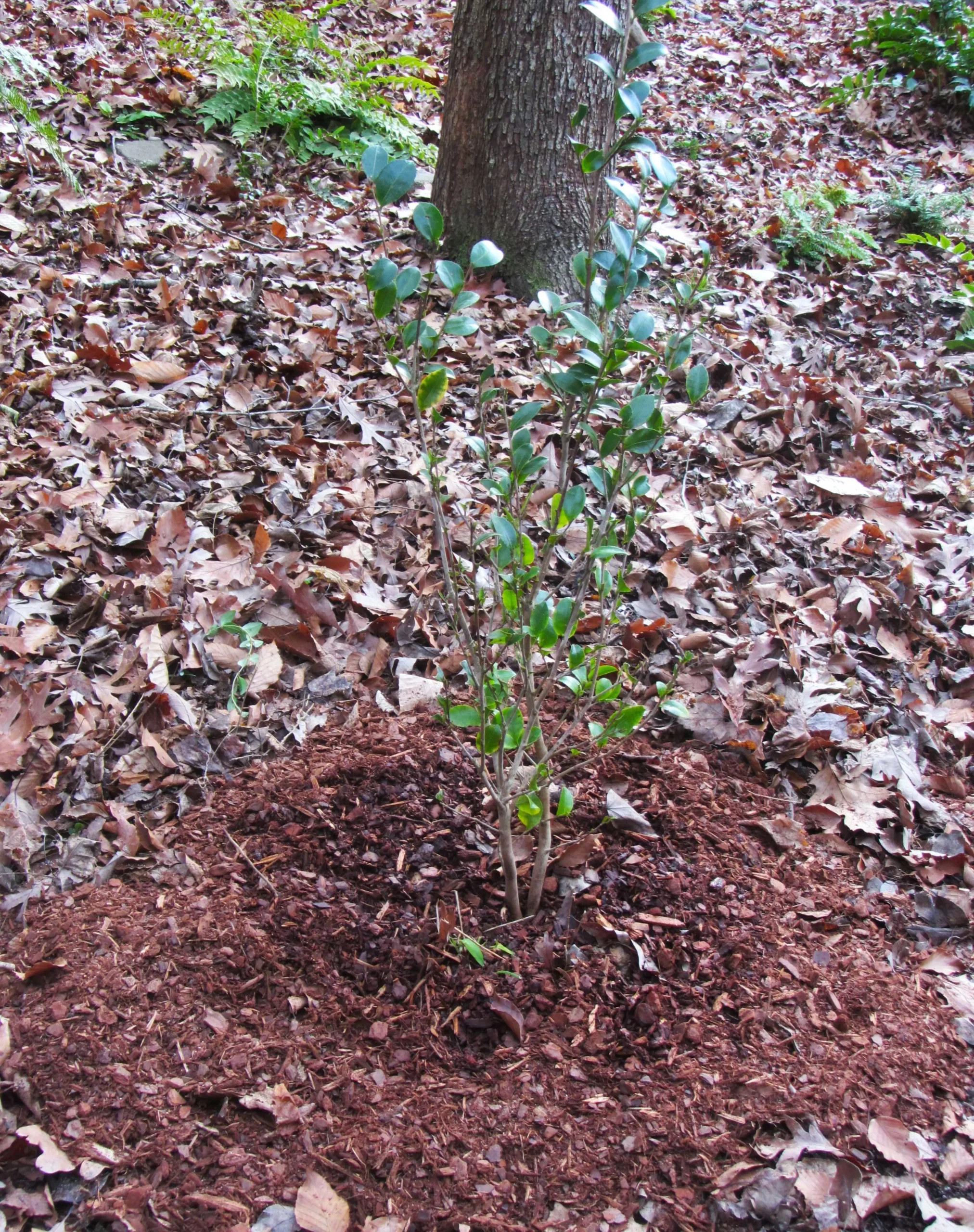
Plant shrubs and perennials whenever the ground is workable from autumn through early spring. Mulch the new planting, but keep the mulch a short distance away from woody stems. This Camellia spent the last several years in a large container and is now planted near our newest fern garden. I planted a ring of (highly poisonous) Narcissus bulbs around the outer edge of the shrub’s root ball to discourage voles from attacking the roots.
Check older bulbs and any stored rhizomes or tubers to make sure they aren’t molded or dead. If any bulb feels too soft, has turned black or grey, or seems to have ‘collapsed,’ then discard it. Moldy or diseased bulbs can transfer that disease to the soil and affect other plants.
Most new, dormant or seedling perennials can be planted in February and March. Plant them in good potting soil in containers and keep them in a sheltered, frost-free spot to encourage early growth.
Plant native tree and perennial seeds in plastic pots or clear milk jugs (with the top ‘hinged’ and then taped closed again) any time between November and January. Place these containers, covered, in a sheltered area outside where the seeds will be exposed to winter cold. The cold treatment is necessary for germination in many species. They will show new growth at the appropriate time in spring. Protect these containers from hungry squirrels and birds that will want to dig in the containers to eat the seeds.
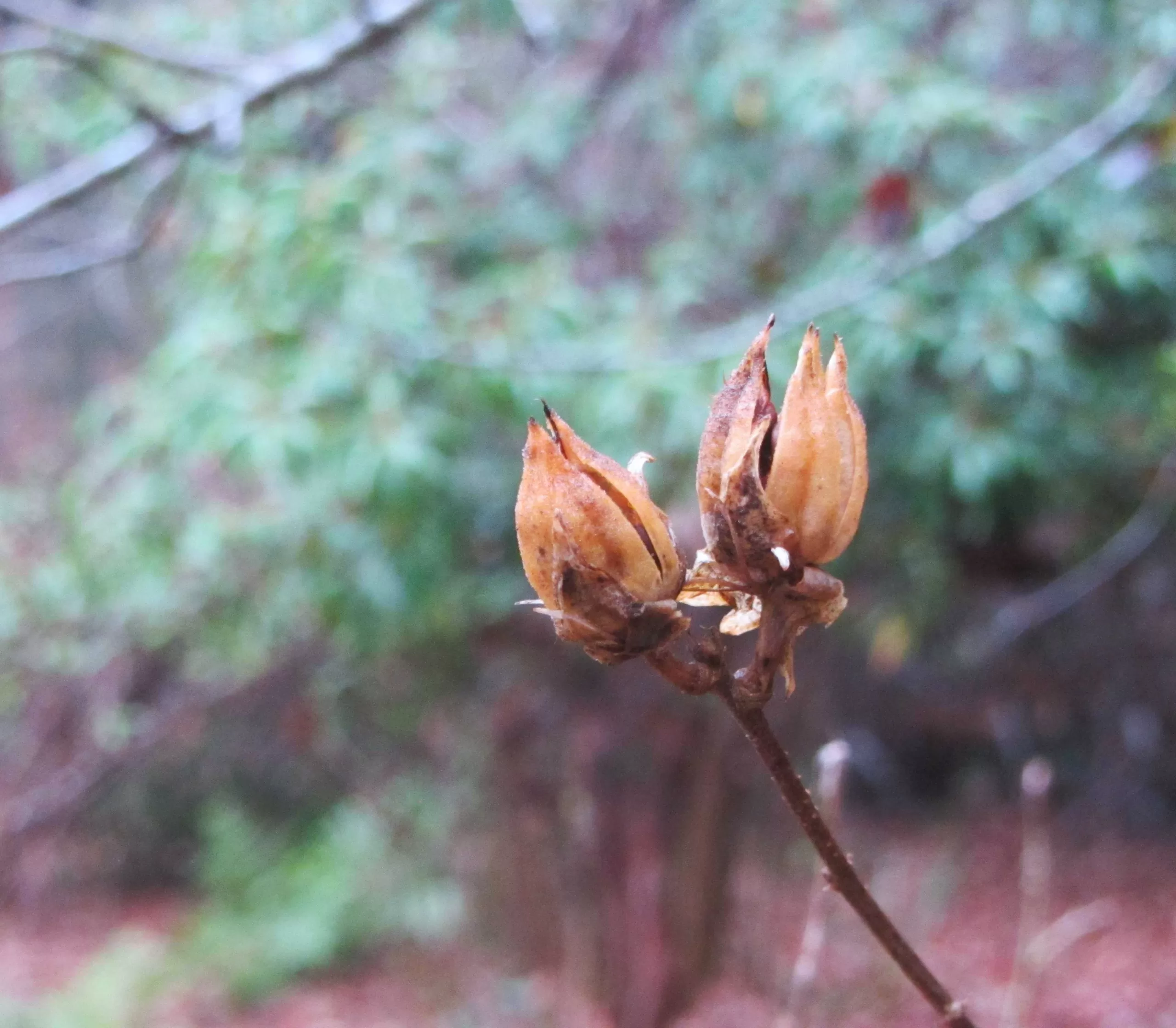
‘Shop’ for seeds in nature. Seed capsules like this Rose of Sharon should get pruned away in late winter. Plant seeds for desirable trees and shrubs in covered containers to leave outside for cold stratification in preparation for spring germination.
Read seed packets carefully to determine when to plant each type of seed for best germination. Start seeds indoors in flats or pots near a window or under lights. Most vegetables and annual flowers should be started six to eight weeks before they are set outside.
Start cold tolerant seeds for early crops like peas, sweat pea flowers, etc. indoors in damp paper towels and plant them out in their permanent location as soon as they crack open and show any growth. Small seeds like radish, onions, leeks, and lettuce should be direct seeded in place or started in a pot or flat, then transplanted. Always direct seed carrots since they form a tap root. Protect newly seeded areas from curious birds and squirrels.
Plant new bare root roses and other flowering shrubs when they come to market in February. Continue planting bare root or container grown shrubs through April or mid-May, but be cautious about planting once the weather heats up. Newly planted shrubs will need regular watering during dry spells for the first year to 18 months, while their root system takes hold in the native soil.
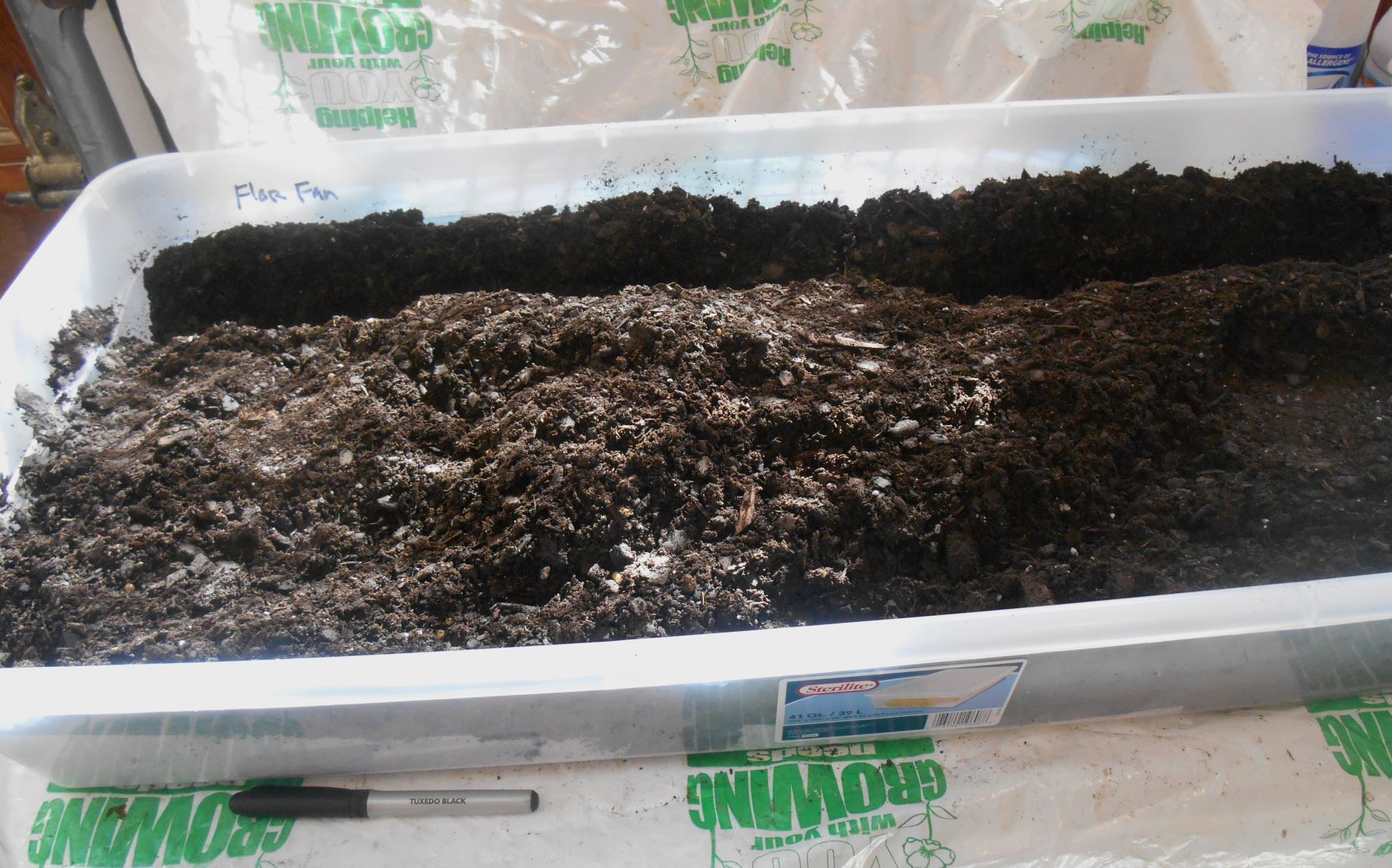
Start Caladium tubers and other warm season geophytes in shallow trays of potting soil about six weeks before you plan to plant them outside. By the time you are ready to plant they should have roots and a few leaves.
To Do Less:
Don’t rush the season for heat loving crops like tomatoes and basil, or for tender perennials like Caladiums and Begonias. Cold weather can stunt the growth of, or harm heat loving plants.
Wait until early April at least to start Caladium tubers indoors and until the ground is at least 60F before planting them outside. Wait until the weather is settled and warm before planting tomatoes or basil outside. Many summer bulbs can be started indoors in plastic nursery pots and then moved outside to a protected porch when the weather is nice. Plant them outside in their permanent spots once all danger of frost and cold nights has passed.
Wait to buy summer annual flowers until the weather is settled unless you can protect them from surprise late frosts.
To Avoid:
Water houseplants and overwintering containerized plants carefully during the winter. They need far less water, but don’t let them dry out completely. Too much water can cause the plant to rot in its pot.
Don’t fertilize most containerized plants between December and mid-February. This is a good time to cut plants back and to root stems of any plants you want to increase.
Don’t move houseplants back outside too early, and don’t immediately set them in full sun. Allow plants to adjust gradually by moving them into the shade at first, and perhaps only during the day. Let them make a gradual adjustment and keep them well-watered when outside.
Sweet Rewards
Sometimes success depends as much on what you refrain from doing, as it does on what you do. Winter is a time when both plants and animals slow down to adjust to shorter days and colder weather. When we work with nature, instead of against her processes, we notice that our lighter touch allows our garden and the ecosystem it supports to survive and thrive. Our reward is renewed energy in the soil, in our plantings, and in ourselves.
All photos by E. L. McCoy
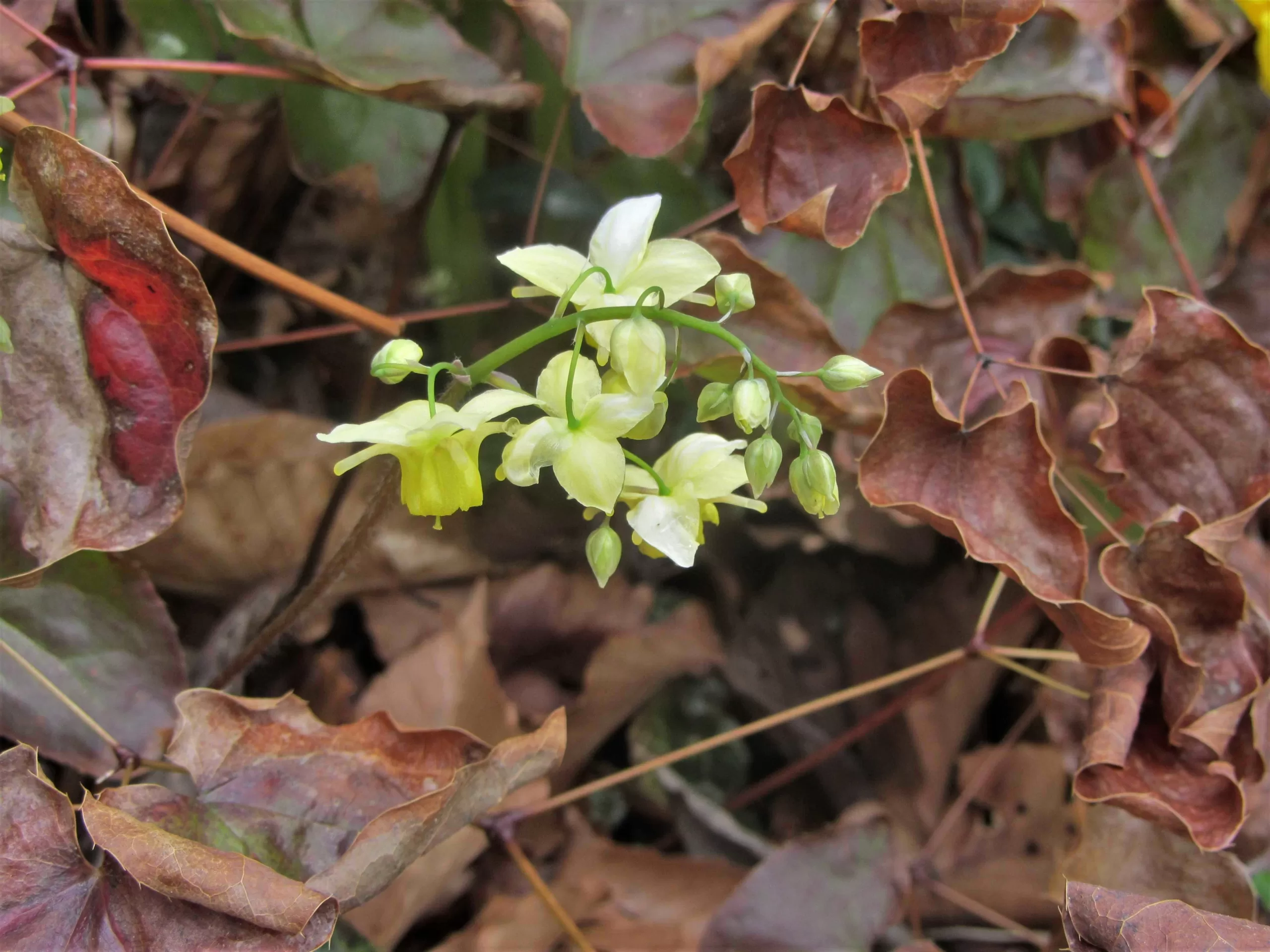
Epimedium thrives in dry shade. Leave these perennials alone and they will thrive year after year. This plant is ready to have its old leaves pruned away as new leaves and flowers emerge.

